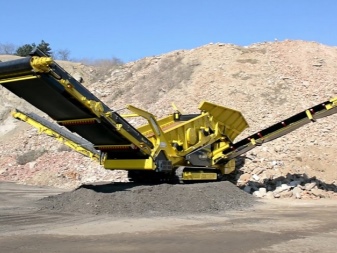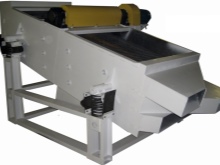Description and selection of crushed stone screens

The description of crushed stone screens can be very important when choosing such a technique. There are mobile vibrating screens on caterpillar tracks and other types. It is necessary to understand the device of models for separating rubble from garbage and with the principle of their work.


general description
Under the name of the crushed stone screen is offered a special device that consists of 1 or more vibrating sieves. With this technique they confidently separate bulk substances, sorting them according to the size of the fraction. Even the simplest apparatus ensures the division of the mass into smaller and larger parts. This is usually sufficient for separation from debris. In most cases, the sorting effect is used in close connection with crushing (disintegration) in adjacent technological units.
The purpose of screening can be to obtain material of a certain size. It is exactly the one that is needed for further technological manipulations, or to return an excessively large mass for revision. But this operation can also be suitable for the separation of marketable crushed stone with a given size level. Such actions are carried out in order to obtain especially precisely aged fractions of the substance.
The principle of operation of any screen is to shake the material on the surface of the technical sieve, which makes it sorted especially efficiently.

Views
The inertial version of the screens is equipped with a single vibrating drive. This propulsion system allows the device to perform vertical orbital vibrations. In order for the material to move over the sieve, the box is placed at a certain angle to the horizon line. This angle cannot be less than 7 and more than 17 degrees. Along with vibration ones, self-balancing models also stand out.
They use a pair of drives, which are in antiphase with respect to each other. The box will oscillate in a straight line. Such a model, in addition to sorting the material, simultaneously ensures its movement along the surface of the screening part. As a result, installation is possible both horizontally and simply at a slight angle to the horizon. Self-balancing technology sorts crushed stone more accurately by size, but at the same time, the total current consumption increases.



In some cases, the so-called "washing" screens are in demand, in which a large volume of water is supplied. The liquid used for washing the crushed stone will have to be somehow disposed of in the future, and the processed product must be dried. The difference may also apply to other parameters of the technique. So, vibrating screens are equipped with sieves with different mesh geometries. Most often it is a square or rectangle, since it was this solution that was considered optimal from an engineering point of view.
The sieves used in the process of cleaning crushed stone are made of wear-resistant materials. Along with conventional steel, rubber lined steel is often used. In some cases, especially resistant polyurethane grades are used.
Vibrating screens can process raw materials with a minimum size of 0.3 mm and a maximum of 300 mm, and the productivity of the equipment ranges from 300 kg to 1200 tons per hour.


Stationary models of crushed stone screens are very productive. They are installed through lengthy preparatory work and the arrangement of the foundation. Mobile devices arrive at the right place on their own and can start working. However, their performance will be less. Moving devices can be tracked or wheeled.
The use of wheels provides increased maneuverability. They make the structure lighter and thus easier to handle. But to work in quarries, it is necessary to use tracked vehicles that are more resistant to negative influences. The working surfaces of the drum screens rotate around the axis. In vibration systems, a specialized vibrating unit is used.


Selection Tips
First of all, you need to pay attention to:
- intended purpose of screening;
- the size of the screening surfaces;
- actual performance;
- The efficiency of the screen;
- moisture content of the base raw materials;
- dry or wet screening option;
- the ability of raw materials to be washed;
- the geometry of the pieces of material;
- the geometric structure of the cells (this nuance should be taken into account).


The do-it-yourself screeners perform excellent screening. And also the equipment can be designed for preliminary (before sending to the crushing machine) or control (after passing through) screening. Finally, there is also a combined processing mode. It is imperative to find out what a particular sample is capable of. When evaluating the productivity and efficiency of screens, engineers analyze:
- granulometric structure of the sifted mass;
- moisture content of raw materials;
- the size and shape of the cells;
- frequencies and amplitudes of the performed vibrations;
- device size;
- physical and mechanical characteristics of the processed material.


The drier the crushed stone is planned to be sieved, the faster it will pass through the mesh of the sieve. Of course, this will directly affect the overall performance. It should be borne in mind that screens can process material either drier than 20% or wetter than 40%. In the interval between these values, the passage of the raw material through the sieve is impossible, because the parameters do not correspond to either dry or wet screening. Ideally, one should consider the balance between the achieved performance and technical efficiency, rather than absolutize one of these points.
Among the parameters of sieving surfaces, there is nothing more significant than the free section. This is the name of the proportion between the total area of the holes and the space in which they are located. The higher this parameter, the more efficient the system.

The size of the individual cells, as well as their shape, are selected primarily for economic reasons and the amount of required productivity. Professionals advise to pay attention even to weather conditions during operation and other external influences.
It is necessary to find out whether it will be easy to replace the screening surface. Its dimensions should change when changing the granulometric characteristics of the processed material. A welded or wire mesh screen will wear out very quickly. The products obtained by the method of splitting or stamping are more durable.
The highest wear resistance is guaranteed by models made of rubber and polyurethane.










The comment was sent successfully.